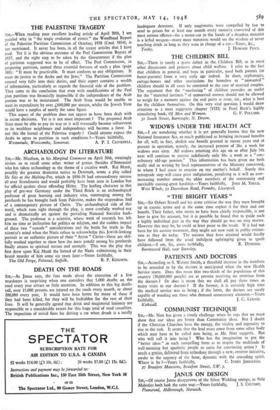ARCHAEOLOGY IN LITERATURE
Sit,—Mr. Nicolson, in his Marginal Comment on April 30th, seemingly invites us to recall some other writer of genius (besides d'Annunzio) who has taken archaeology as the theme of a creative work. Kaj Munk, possibly the greatest dramatist native to Denmark, wrote a play called He Sits at the Melting-Pot, which in 1938-39 had extraordinary success all over Scandinavia and would probably have been seen in London but for official qualms about offending Hitler. The leading character in this play of pre-war Germany under the Third Reich is an archaeological professor of great learning and industry who, rummaging among the potsherds he has brought back from Palestine, makes the stupendous find of a contemporary picture of Christ. The archaeological side of this motif, which runs right through the play, is most carefully worked out and is dramatically set against the prevailing National Socialist back- ground. The professor is a scientist, whose work of research has left him no time or inclination for politics or religion, and the sudden impact of these two " outside" considerations and the battle for truth in flee scientist's mind when the Nazis refuse to acknowledge this Jewish-looking portrait as an authentic picture of their " Aryan " Christ—these are skil- fully worked together to show how the mere pundit among his potsherds finally attains to spiritual stature and strength. This was the play that first drew upon Kaj Munk the hatred of the Nazis, culminating in their brutal murder of him some six years later.—Yours faithfully,






























 Previous page
Previous page